 Fruit and vegetables in “Via Mentana”.
Fruit and vegetables in “Via Mentana”. A bookbinder in “Corso Amedeo”.
A bookbinder in “Corso Amedeo”.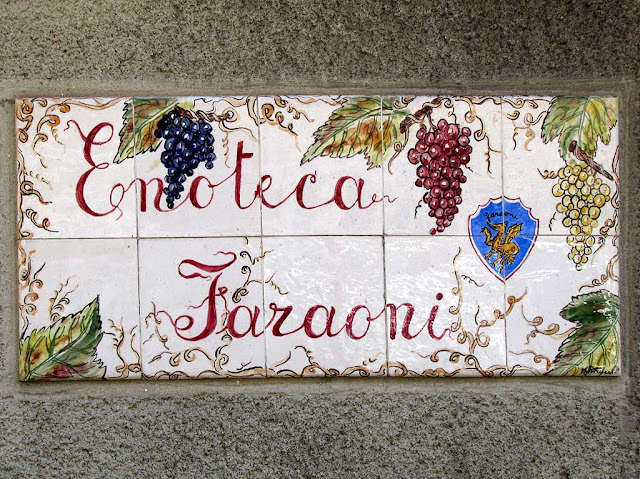 A wine shop, again in “Via Mentana”.
A wine shop, again in “Via Mentana”. Fruit and vegetables in “Via Mentana”.
Fruit and vegetables in “Via Mentana”. A bookbinder in “Corso Amedeo”.
A bookbinder in “Corso Amedeo”. A wine shop, again in “Via Mentana”.
A wine shop, again in “Via Mentana”. When I was a kid I suspected that this massive structure on the top of “Monte Burrone” (Mount Ravine) was a money bin of sorts, like the one where Scrooge McDuck stored his dollars.
When I was a kid I suspected that this massive structure on the top of “Monte Burrone” (Mount Ravine) was a money bin of sorts, like the one where Scrooge McDuck stored his dollars. The huge “cube” was part of the mausoleum of Costanzo Ciano, the powerful local Fascist leader whose son Galeazzo married Edda, the daughter of Mussolini.
The huge “cube” was part of the mausoleum of Costanzo Ciano, the powerful local Fascist leader whose son Galeazzo married Edda, the daughter of Mussolini. It was practically intended as a giant plinth for a 12 meter statue honoring him as naval commander and as the base for a 50 meter tall fasces-shaped light.
It was practically intended as a giant plinth for a 12 meter statue honoring him as naval commander and as the base for a 50 meter tall fasces-shaped light. The war and the fall of the Fascist regime stopped the works, then the Germans blew up the light. The building and the surrounding area, not far from Montenero, had been abandoned since.
The war and the fall of the Fascist regime stopped the works, then the Germans blew up the light. The building and the surrounding area, not far from Montenero, had been abandoned since. Part of the half-finished statue still lies in a cave on the island of Santo Stefano, in the Maddalena archipelago of northern Sardinia.
Part of the half-finished statue still lies in a cave on the island of Santo Stefano, in the Maddalena archipelago of northern Sardinia.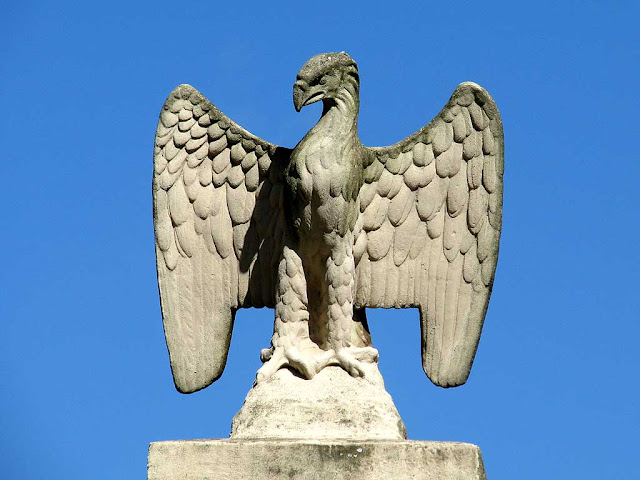 This time is Trillian who is wandering the streets of Quercianella: her first catch is a frowning eagle of “Villa Jana”.
This time is Trillian who is wandering the streets of Quercianella: her first catch is a frowning eagle of “Villa Jana”. A table outside the renowned restaurant and hotel “Sottocosta”.
A table outside the renowned restaurant and hotel “Sottocosta”. A lone hibiscus (Thanks, ciel!) outside a “villetta”.
A lone hibiscus (Thanks, ciel!) outside a “villetta”. The sun and the moon together on a wall.
The sun and the moon together on a wall. Who can resist a convex mirror?
Who can resist a convex mirror? A “villettina” is a smaller villa or “villetta”, but in this case there is probably around some lady called Tina.
A “villettina” is a smaller villa or “villetta”, but in this case there is probably around some lady called Tina.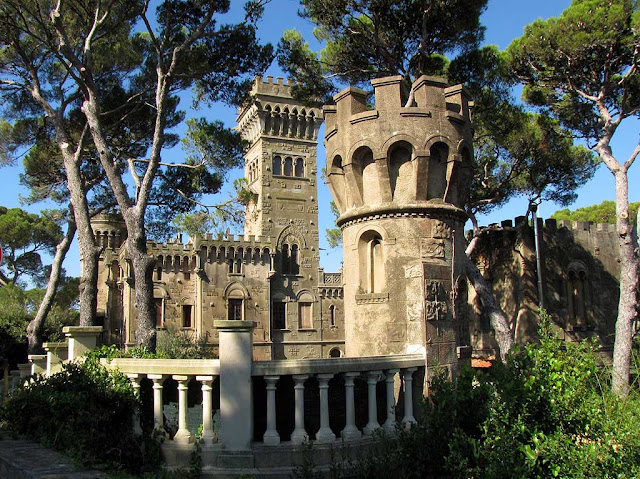 “Villa Jana”, or “Castel Jana” as modestly written on a plaque at the main gate, is a striking structure in eclectic style built in 1921 in the outskirts of Quercianella.
“Villa Jana”, or “Castel Jana” as modestly written on a plaque at the main gate, is a striking structure in eclectic style built in 1921 in the outskirts of Quercianella. Quercianella, an administrative division of Livorno, is a lovely seaside resort and the southernmost part of our Municipality.
Quercianella, an administrative division of Livorno, is a lovely seaside resort and the southernmost part of our Municipality.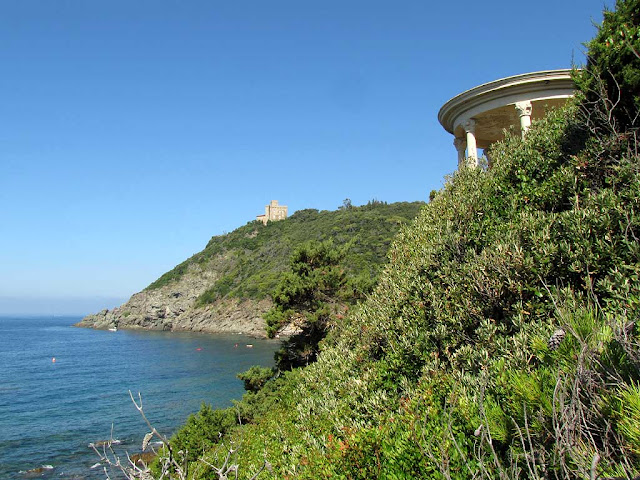 The belvedere of the villa faces the bay on the south of the Romito headland, dominated by “Castel Sonnino”.
The belvedere of the villa faces the bay on the south of the Romito headland, dominated by “Castel Sonnino”. The villa has a turreted access to a small jetty...
The villa has a turreted access to a small jetty... ... and to a pebble beach nearby.
... and to a pebble beach nearby. |  |  |  |
| Castello del Boccale | Torre di Calafuria | Calignaia | Castel Sonnino |
 I forgot this walk. It was the Sunday after the White Night and it was reassuring to see in “Piazza XX Settembre” the face of Alfredo Kraus, one of the greatest tenors of the last century. Not sure of his feelings about “Caballeria Rusticana”.
I forgot this walk. It was the Sunday after the White Night and it was reassuring to see in “Piazza XX Settembre” the face of Alfredo Kraus, one of the greatest tenors of the last century. Not sure of his feelings about “Caballeria Rusticana”. I saw this (dry) fountain in a courtyard inside the building called “Palazzi Rossi”, I have never noticed it before...
I saw this (dry) fountain in a courtyard inside the building called “Palazzi Rossi”, I have never noticed it before... This asinine writer wrote “avvolte” (which is “wrapped”) instead of “a volte”, which is “sometimes”.
This asinine writer wrote “avvolte” (which is “wrapped”) instead of “a volte”, which is “sometimes”. The building of the “Biblioteca dei Ragazzi”, the Children's Library in the park of “Villa Fabbricotti”.
The building of the “Biblioteca dei Ragazzi”, the Children's Library in the park of “Villa Fabbricotti”. Discovered by Christopher Columbus on the Caribbean island of Guadeloupe in 1493, pineapples became a rare delicacy in Europe, and were symbolic of power, wealth, and hospitality. The pineapple was adopted as a motif by architects, artisans and craftsmen, being sculpted into gateposts, railings, weather vanes and door lintels. (Pineapples as a decorative motif, Wikipedia).
Discovered by Christopher Columbus on the Caribbean island of Guadeloupe in 1493, pineapples became a rare delicacy in Europe, and were symbolic of power, wealth, and hospitality. The pineapple was adopted as a motif by architects, artisans and craftsmen, being sculpted into gateposts, railings, weather vanes and door lintels. (Pineapples as a decorative motif, Wikipedia). “Via Grande”, our main street, was practically destroyed by the Allied air raids. After the war the only building still standing was the “Palazzo del Picchetto”.
“Via Grande”, our main street, was practically destroyed by the Allied air raids. After the war the only building still standing was the “Palazzo del Picchetto”. After the war the whole street was rebuilt with wide porticoes flanking both sides, from “Piazza Guerrazzi” to the Old Harbor.
After the war the whole street was rebuilt with wide porticoes flanking both sides, from “Piazza Guerrazzi” to the Old Harbor. There were shops, bars, movie theaters and even two department stores. Now some of the old shops are closing for good, the movie theaters are gone and only a few international chains are opening new stores.
There were shops, bars, movie theaters and even two department stores. Now some of the old shops are closing for good, the movie theaters are gone and only a few international chains are opening new stores. Colorful shutters in “Via di Salviano”. This “cantina” offfers free home delivery of wines, bottled or from the cask.
Colorful shutters in “Via di Salviano”. This “cantina” offfers free home delivery of wines, bottled or from the cask. I think “Il bello delle donne” (The beautiful thing about women) is inspired by an Italian TV series.
I think “Il bello delle donne” (The beautiful thing about women) is inspired by an Italian TV series. “Modì” was the nickname of Amedeo Modigliani and is still used by countless unrelated shops in town.
“Modì” was the nickname of Amedeo Modigliani and is still used by countless unrelated shops in town. The “Chiesa degli Olandesi” (Dutch Church) was owned by the Dutch German congregation, which ceased to exist in the 1960s. The lack of an active congregation was the prime cause of the decline in the state of conservation of the temple.
The “Chiesa degli Olandesi” (Dutch Church) was owned by the Dutch German congregation, which ceased to exist in the 1960s. The lack of an active congregation was the prime cause of the decline in the state of conservation of the temple. Some basic maintenance was assured by the descendants of the members of the former congregation, but this was not enough to block the construction of an apartament building just behind the church or to avoid the demolition of the spires for safety reasons. Already in 1996 there was some water damage inside the church due to leaks, the walls were unsafe and the great glass panels of the windows had been shattered.
Some basic maintenance was assured by the descendants of the members of the former congregation, but this was not enough to block the construction of an apartament building just behind the church or to avoid the demolition of the spires for safety reasons. Already in 1996 there was some water damage inside the church due to leaks, the walls were unsafe and the great glass panels of the windows had been shattered. In 1997 the congregation was formed again and a new project was presented with the idea of opening the temple for cultural events and not just for worship. After the last war the church, with its excellent acoustics due to its slender shape, was already being used as an auditorium . Sadly, the organ, one of the best in Tuscany, was stolen during the war.
In 1997 the congregation was formed again and a new project was presented with the idea of opening the temple for cultural events and not just for worship. After the last war the church, with its excellent acoustics due to its slender shape, was already being used as an auditorium . Sadly, the organ, one of the best in Tuscany, was stolen during the war. With the new millennium the roof was somewhat fixed and the windows repaired, but a few years after, in 2005, part of the ceiling collapsed on the old wood benches. Another minor collapse was visible in 2008 on the structure to the left of the main entrance.
With the new millennium the roof was somewhat fixed and the windows repaired, but a few years after, in 2005, part of the ceiling collapsed on the old wood benches. Another minor collapse was visible in 2008 on the structure to the left of the main entrance. The congregation has no funds to finance any rebuilding without outside support and it is not even able to suggest a practical project for this temple. The lack of public interest about this building is amazing; people and politicians seem really not to care about it. The wall of the canal in front of the church collapsed 15 years ago and has still to be rebuilt.
The congregation has no funds to finance any rebuilding without outside support and it is not even able to suggest a practical project for this temple. The lack of public interest about this building is amazing; people and politicians seem really not to care about it. The wall of the canal in front of the church collapsed 15 years ago and has still to be rebuilt. To publicize this situation letters have been sent to the press, to the local council, to the Department of National Heritage and even to the Embassies of The Netherlands and Germany.
To publicize this situation letters have been sent to the press, to the local council, to the Department of National Heritage and even to the Embassies of The Netherlands and Germany. A plaque in “Via Micali” reminds us that the poet Giovanni Pascoli lived here in 1887-8. He was teaching at our “liceo classico” and wrote here part of “Myricae” (Tamarisks), his first poetic work.
A plaque in “Via Micali” reminds us that the poet Giovanni Pascoli lived here in 1887-8. He was teaching at our “liceo classico” and wrote here part of “Myricae” (Tamarisks), his first poetic work. Fake green and flower are another kind of poetry in “Via Battisti”.
Fake green and flower are another kind of poetry in “Via Battisti”. Watch out for the dog, in “Via Oberdan”.
Watch out for the dog, in “Via Oberdan”. “Trattoria da Motorino” (Scooter's Trattoria), a renowned restaurant.
“Trattoria da Motorino” (Scooter's Trattoria), a renowned restaurant. Church of “San Benedetto” in “Piazza XX Settembre”, some of the old tombstones in the facade.
Church of “San Benedetto” in “Piazza XX Settembre”, some of the old tombstones in the facade.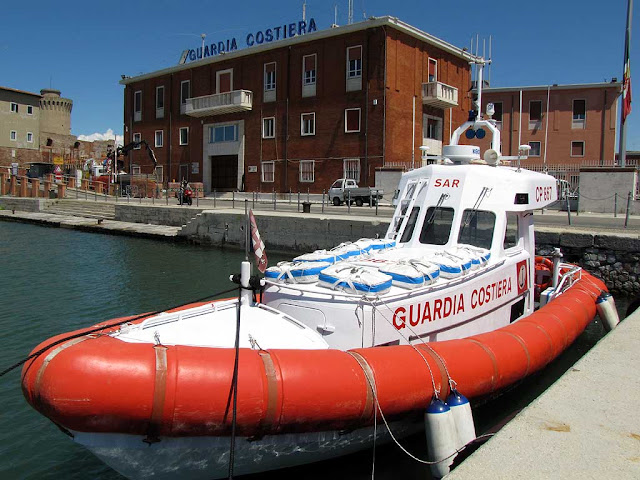 A Class 800 S.A.R. (Search and Rescue) patrol boat in front of the “Guardia Costiera”, the Coast Guard local headquarters.
A Class 800 S.A.R. (Search and Rescue) patrol boat in front of the “Guardia Costiera”, the Coast Guard local headquarters.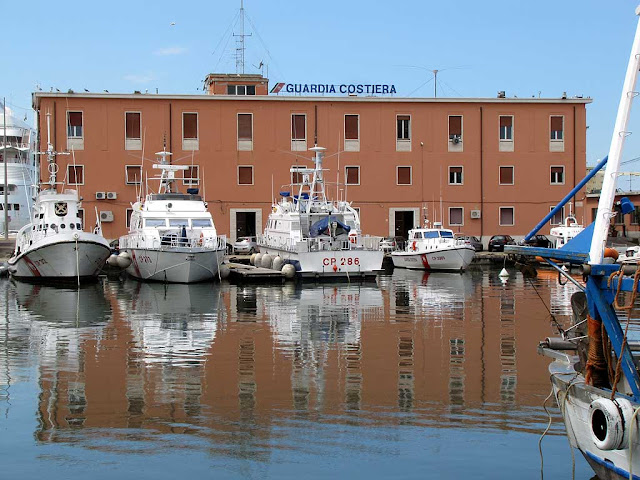 The other side of the building, where the boats are moored, faces the “Pamiglione” or Old Harbor.
The other side of the building, where the boats are moored, faces the “Pamiglione” or Old Harbor. The same boat of the first image leaving port at full speed.
The same boat of the first image leaving port at full speed. Walking from “Piazza Damiano Chiesa” toward the “Salesiani”, we meet soon this unusual giraffe pattern chimney.
Walking from “Piazza Damiano Chiesa” toward the “Salesiani”, we meet soon this unusual giraffe pattern chimney. The “Galliano Masini” park is sadly closed on Sunday.
The “Galliano Masini” park is sadly closed on Sunday. The “villetta” where the tenor once lived.
The “villetta” where the tenor once lived. This statue of the Virgin Mary and child, on the corner of the Salesiani's building, was a gift from the archbishop Felice Guerra, a name which is literally... Happy War!
This statue of the Virgin Mary and child, on the corner of the Salesiani's building, was a gift from the archbishop Felice Guerra, a name which is literally... Happy War! The Salesian movie theater showing some version of “Pinocchio”.
The Salesian movie theater showing some version of “Pinocchio”.